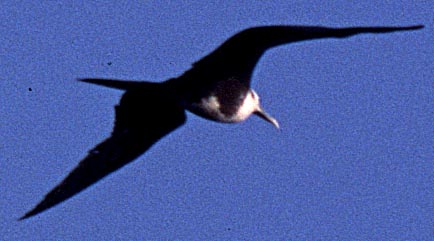
Stan Walens sent the photo to Tony Palliser of Australia who thought the bird was probably a Magnificent. Palliser forwarded the photo to David James who has been studying Greater and Lesser Frigatebirds. James offered the following analysis published here by permission:
I presume this is from the north pacific? It looks like a juvenile Magnificent to me. Both the pattern of the black wedges (tabs) on the sides of the breast and the shape of the belly patch are important. The wedges indicate juvenile plumage. The leading edge of the wedge is angled strongly backwards (diagonal) verse angled mostly downwards (about 80 degrees) in Great. This means that the amount of white on the breast in front of the wedges is more extensive in Magnif because the wedges angle backwards. Howell states that the sharpness of the points on the wedges is important (sharper in Magnif.) but the photo doesn't show this well. The belly patch of Magnificent is more diamond-shaped than great, with more defined corner angles; the WHITE rear edge to the belly patch on the flank is concave in Magnif and convex in Great (i.e. black sweeps further down on the flanks of Magnificent). These points are described and illustrated in Howell (1994: 'Magnificent and Great Frigatebirds in the Eastern Pacific' Birding, Dec. 1994 p. 400-415), and the illustrations provide a guide to judging the subtle differences. Steve Howell is the expert on separating these two, so you could ask him for another opinion.
This mystery frigatebird was photographed at La Jolla Cove, San Diego County 4 January 2002. What species and age is it? Stan Walens has offered the following comments:
The viewer is behind and to the lower right of the bird; the sun is coming from the upper right.
The bird is flying away up and to the left, so it is tilted so that the right wing is higher than the left wing.
Also, it is just about to make a further curve to the left, so the head is slightly turned that way. So, the underside
of the bird is lit pretty well.
Things to know about the picture as a picture:
1. this is the only photo that anyone got.
2. the area of the vent and lower belly beneath the obvious white was pretty solid black. This black in the body
went up until about the midpoint of the wings. In the photo the sun reflecting off the black feathers of that area
makes them look vaguely whitish, just as it does as it reflects off the feathers on the underside of the left wing.
3. We do not think that the brownish-buff wash visible on the upper breast of the bird is an artifact of the photo,
but none of us noticed such a wash in the field. We all thought of the bird as basically white, but we also were
staring hardest at the underside of the wings, looking for axillar scalloping. Did not see the color of the feet
either.
To view public comments or join the fray by adding your opinion, click here. Have fun!
 |
Photo © Tony Mercieca. All rights reserved. |